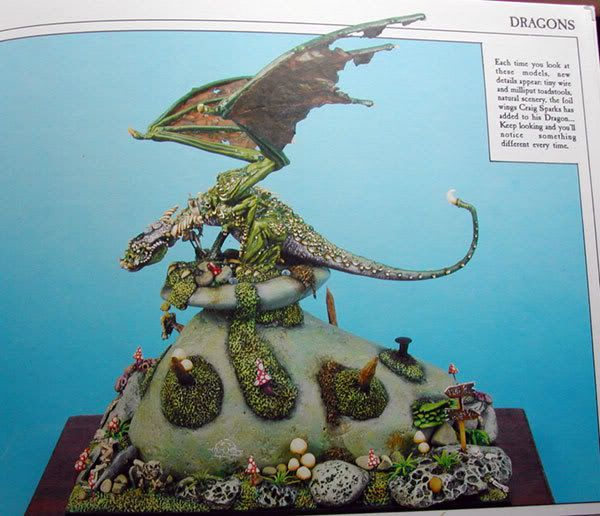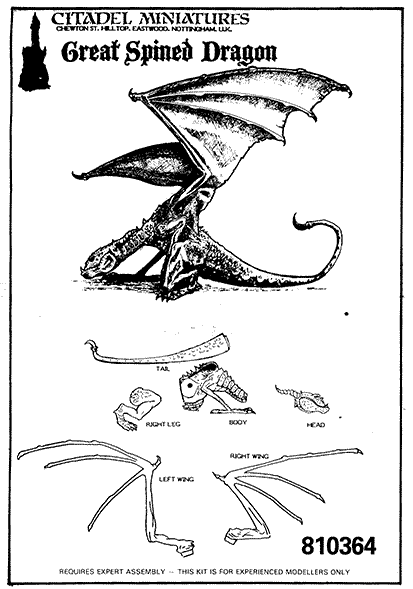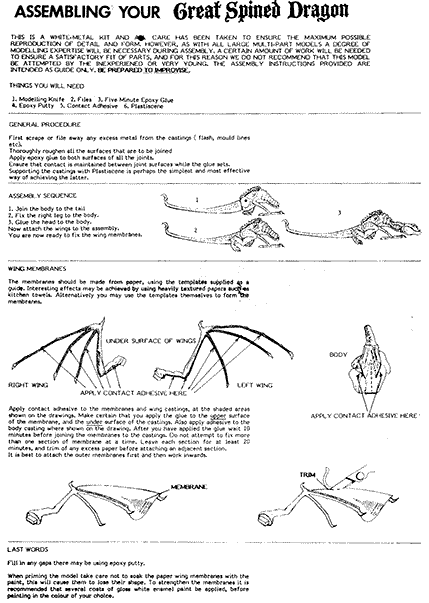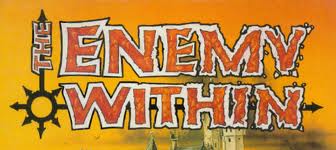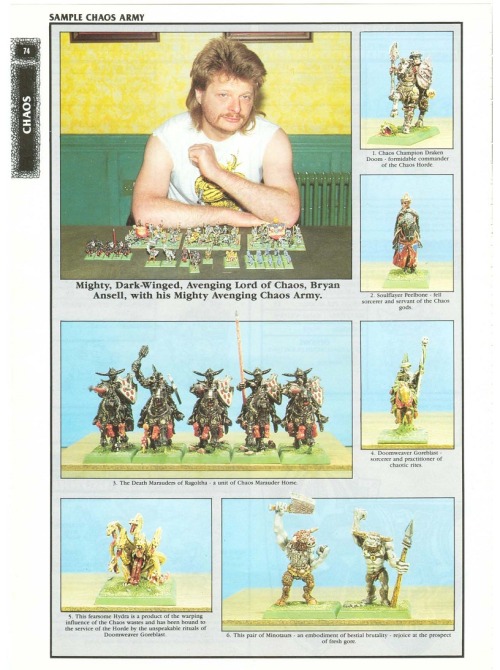 |
| Midnight Rogue - Graeme's only contribution to Fighting Fantasy, so far! |
Midnight Rogue was a gift from my mother for Christmas in 1988, or there abouts. I still have the copy to this day, in a box buried deep within the garage, though I have never got around to playing it. I had the bizarre notion (in fact I still have the same bizarre notion) of having to complete all of the Fighting Fantasy books in the order that they are written.
So far, I have got to the Island of the Lizard King.
A while yet, until Midnight Rogue, then.
Graeme Davis wrote Midnight Rogue. He also wrote (as part of a wider team) the Warhammer Fantasy Roleplay rulebook, and one of its most famous adventures; Shadows over Bogenhafen. Graeme published his first article in White Dwarf in 1982. before joining the Design Studio four years later in 1986, and contributed to a wide range of different products, some published, others, sadly, never materialising. He is the subject of RealmofChaos80s' latest interview about all things old school. Graeme discusses the development of WFRP, Realm of Chaos and a great many other things, and also brings us a number of behind the scenes details and a few snippets of information about things that never made it into Warhammer Third Edition and WFRP.
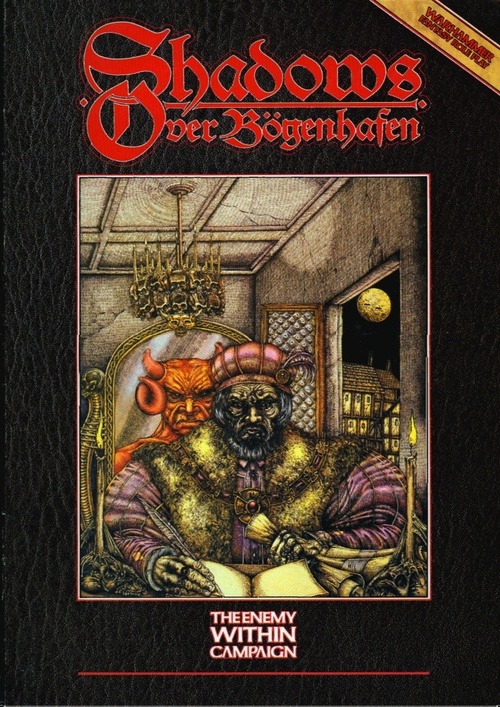 |
| Graeme worked on this classic adventure. Those of you who have played or GM'ed this game will know just how interesting the scenario is. |
RoC80s: What caught your interest and got you involved in fantasy roleplaying in the first place?
|
GD: This goes back to the '70s. I'd grown up building Airifx kits, mostly of WWII planes and tanks. Someone at school tried to start a wargaming club, but it didn't take. I played one naval battle where each of us had one ship and didn't enjoy it much because only the two team leaders were actually playing and all the rest of us got to do was move the scraps of paper representing our ships.
The club folded shortly after that.
In about 1975 I started doing school plays, and I joined a local amateur dramatics group after I left school. I heard from some people there about a new game called Dungeons & Dragons, which was part wargame and part improvised theatre. The two seemed incompatible to me, so I went and played a game to find out what it was all about. I had two characters, both thieves, and both killed by a minotaur in the first game, but I enjoyed the game and went back. That would have been about 1977. I liked the fantasy elements because I had grown up reading Greek and Arthurian mythology and watching movies like Ray Harryhausen's version of "Jason and the Argonauts." The scene with the skeletons gave me an unhealthy obsession with the undead that continues to this day.
RoC80s: You were a very early contributor to White Dwarf. What was it like to write and submit articles during this period?
|
GD: It was fun. I was at college, playing far too much AD&D and branching out into Bushido and Call of Cthulhu. It took two years for my first article to get published - it was a set of rules for drug addiction in AD&D which I doubt would be publishable today - and after that I usually sent a couple of articles a month. Everything was on spec: I just sent whatever I thought the editors would like, and mostly they did like what I sent. It didn't pay much - 1p a word at the time - but it was a good source of beer money.
RoC80s: How did you move from submitting articles to full blown game designing?
|
GD: Inspired by Bushido and by my love of Irish myths and sagas, I started to design a Celtic RPG called Fiana while I was at college. It never got beyond a couple of playtests sessions. In the winter of 1985-86 I was commissioned to write a series of gamebooks for Oxford University Press - gamebooks were all the rage then, and these were aimed at teenagers with a reading age of about 7, using the gamebook format to encourage them to read. I never made a conscious move from writing articles to designing games: it was all RPGs.
 |
| The main rulebook for WFRP; Graeme was a major contributor to this title. |
RoC80s: Explain how you joined the GW design studio? Was it natural progression or something different?
|
GD: I'd been writing for TSR UK's Imagine magazine as well as White Dwarf, and after Imagine folded several TSR UK staffers moved to GW. I heard from Paul Cockburn in April 1986 and was invited down to Nottingham to talk about working on the game that became WFRP. After a couple of meetings with Paul, Rick, Hal, and Jervis, I joined the staff that May.
RoC80s: How much can you remember about who you worked with at the Design Studio? Was it a creative place as others have said?
|
GD: It really was. We joked around a lot and bounced ridiculous ideas off each other to see what we could get away with. We all had a similar sense of humour, which could range from the juvenile to the surreal to the completely random. Initially I was working from three separate stacks of notes provided by Rick, Hal, and Bryan Ansell, and after Jim and Phil arrived we finished knocking the rulebook into shape and Jim and Phil laid the foundations of the Enemy Within campaign.
There was a pool of writers - me, Rick, Hal, Jim, Phil, Marc Gascoigne, and Mike Brunton - and we did whatever needed doing at the time, ranging from developing new games to writing support articles, reviews for WD, ad copy, box backs, and going through the WD submissions pile, which at one time consisted of two stacks of paper over five feet high. Rick was mostly writing 40K at the time; Hal was working on Space Hulk, the 2000AD board games, and Dark Future; Jervis was developing Blood Bowl and then Adeptus Titanicus/Space Marine. I worked fairly closely with Jervis on those two, smoothing out the wording of the rules and adding the little bits of atmospheric fiction as well as writing a few support articles for White Dwarf. Paul was White Dwarf editor, and Mike worked on pretty much everything at various points. He was the "last writer standing" when Realm of Chaos was finally published, and of course he went on to succeed Paul as White Dwarf editor. Marc developed the setting for Dark Future and ran Warlock magazine once it came into GW before moving to Penguin. Later on Steve Hand joined the studio, bringing Chainsaw Warrior and Fury of Dracula with him as finished designs. He worked on a number of board games once he arrived, but I still think those two were his best work.
 |
| The handout that starts it all: Wanted Bold Adventurers! |
RoC80s: What is your version of events behind the development and publication of the Warhammer Fantasy Roleplay ruleset and starting adventure, The Oldenhaller Contract?
|
GD: When I arrived, WFRP consisted of a rough draft by Rick and a lot of notes and ideas from Bryan and Hal. I did my best to fold everything together and develop a new draft, filling in any gaps with systems I had designed myself - like the section on divine favour and disfavour, for example. Hal seemed to come up with two or three new careers every day, often based on people he'd seen around Nottingham: some got very silly indeed, some were no more than half-formed ideas, and we only used about half of them in the end. As the weeks went by, the system shifted. Character stats started out being identical to Warhammer Battle, but we found that a 1-10 scale didn't give us the resolution a roleplaying game needed, so many were switched to percentile. After the first few playtests showed how deadly combat was, Jervis came up with the idea of fate points. I scoured old Warhammer products and Citadel catalogues to make sure the Bestiary contained every possible monster, which is why there were strange things like the Life and Death Elementals. The Warhammer Mythos hadn't really taken shape yet, so it was hard to say what would last and what wouldn't.
The Oldenhaller Contract was written by Hal and I did little more than edit the text. It wasn't really intended to set the tone for the game - any more than Shadows Over Bogenhafen was - but we just felt the rulebook needed a sample adventure so people could start playing right away.
RoC80s: The first half of the Enemy Within has been lauded as one of the greatest, if not the greatest, set of adventures ever produced for an RPG. What was the story behind their development and what influenced you the most when working on them?
|
GD: When Jim and Phil arrived at the studio, I was already part-way through writing Shadows Over Bogenhafen. The story behind it is pretty well-known, I think: Bryan told me to write a "bloodless ... Call of Cthulhu adventure for Warhammer," and that's what I did. I was thinking it would be a one-off module, but Jim and Phil wrote it into the Enemy Within campaign and the rest is history. They were the prime movers behind the campaign; they had co-written a great campaign module called "Night's Dark Terror" for TSR UK, and they knew what a campaign was and how to make one. While I finished up Shadows they wrote The Enemy Within and planned out the rest of the campaign. They wrote the bulk of Death of the Reik while I put together the "River Life of the Empire" booklet; from time to time we would switch and edit each other's work, but the structure and direction of the campaign was all Jim and Phil. Influences are tough to pin down. Certainly Call of Cthulhu was an influence on Shadows Over Bogenhafen, right down to the title, which I stole from Lovecraft's story "The Shadow Over Innsmouth." Marlowe's Faust was another big influence, of course; the basis of the plot was that Teugen had made a Faustian pact with Chaos and was trying to get out of it. The whole campaign, like most things published for WFRP, was riddled with one-liners and in-jokes like the German(ish) names and pop culture references from Monty Python to Blackadder, but I don't know that those really count as references. You'd have to ask Jim and Phil about influences for Death on the Reik, although I suspect that Gormenghast, at least, was in their minds while they were designing Castle Wittgenstein.
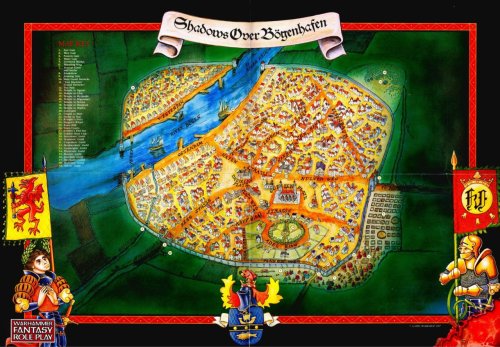 |
| A full colour map of Bogenhafen, detailing many of the locations you can visit in the game. |
RoC80s: Apart from WHFP, what other roles did you have at the Studio? For instance, is it true you wrote many of the amusing little tales that often supported releases in White Dwarf?
|
GD: As I said earlier, the writing pool basically did whatever needed doing at the time. I wrote a few of the silly stories on box backs and ads - I think the Skull Crusher trebuchet was my first - but Rick also did quite a lot of them and I was influenced by those and his work on the Regiments of Renown supplement for 1st edition Warhammer. I wrote product ads - I'll never forget one occasion where a page had to be replaced at the last minute and Chaz Elliot, the graphic design head, came screaming downstairs with a pencil of a page layout and told me a taxi was waiting outside reception to take the page to the printer once I'd written the text for these boxes here, here, and here. I wrote reviews, I edited and developed rules written by Jervis, Hal, and other designers, I finally managed to get the WD submissions pile down to less than a foot high, I edited the WD letters column a couple of times and ran a semi-regular WFRP Q&A column called "On the Boil" (a typical example of Design Studio humour at that time). And I'm sure there were other things that I have since forgotten.
RoC80s: Explain the rational behind Flame Publications and give us an idea what it was like to work there, was it different to the Design Studio?
|
GD: It was very different. After the success of 40K, it became clear that the real money was to be made in miniatures games, and GW's roleplaying games efforts were increasingly sidelined. Since my main interest was in RPGs, this was frustrating, and I'm sure I wasn't the only one who worried that WFRP would wither and die. The idea of a separate roleplaying imprint had been bouncing around the studio for a couple of years - I think it was Paul Cockburn who first proposed it - but no one thought it would happen until Tom Kirby called Mike and me into his office one day. He told us we could have one artist and we asked Tony Ackland if he wanted to do it, and he agreed right away. Flame was very different from the Studio, and not just because there were only three of us and we got to devote ourselves to roleplaying material. Over the three years or so since WFRP was released, the atmosphere at the studio had changed quite considerably. As Bryan was spending more time getting the US side up and running, a layer of middle management had grown up between the creative and executive strata: decisions took longer to make, they were often harder to understand - for me at least - and discussion was strongly discouraged. I remember one occasion when I was handed back a draft of a book I had written - a rules-free sourcebook on Ogre and Trolls in the Warhammer world - and told to rewrite it. When I whipped out my pad and asked what needed to change, I was told (and this is a direct quote to the best of my recollection) "I'm not going to tell you that. Just rewrite it." All in all, I had the impression that no one wanted to put their name on any decision in case it turned out that Bryan didn't like it. While we at Flame mostly enjoyed the separation we had from the main studio, I had the impression that relations were less than cordial. Mike had the job of liaising, and it wasn't a task I envied him.
 |
| Castle Drachenfels: the final product produced and released by Flame Publications. |
RoC80s: You have stated that you had minimal involvement in Realm of Chaos Slaves to Darkness. Even so, what are your memories of the project?
|
GD: I think I was the penultimate writer to work on it. I made a few mis-steps, like trying to include Malal, and by the time it reached me the whole thing had been through so many writers that it was quite unwieldy. Realm of Chaos was always a bit of a moving target: it was well-known that it was Bryan's pet project, but honestly I don't think I ever knew exactly what he wanted from it, and he was always too busy to sit down and come up with a firm brief for the thing. His direction consisted of seemingly random pronouncements whenever he happened to pass by - I'll never forget the time he stuck his head round my door, said "We need more maggot-ridden pus, you know," and kept walking - and while I longed to declare a moratorium on new ideas so I could kick what I had into some kind of shape, I didn't have the confidence to tell that to the man who owned the company. In the end, I became convinced that I was doing more harm than good on the project, and I asked to be replaced. Mike took it over, and to this day I'm lost in admiration of the fact that he actually got it finished.
RoC80s: Was there ever a real drive to develop a deep Warhammer Mythos? You mentioned additional gods of chaos, were there other things that you worked on that never made it?
|
GD: Not really. The Warhammer Mythos developed organically; new stuff was added as it was needed. A lot of the creative drive came from the miniatures designers. When Jes Goodwin created the Skaven they were immediately incorporated, when the Perry twins started doing Bretonnian knights Nigel Stillman expanded the Bretonnia background, and so on. I always had the sense that we didn't want to commit ourselves to anything that would limit our options later on. Two freelancers (Dave Morris and Oliver Johnson, if memory serves) were commissioned to develop an Oriental setting under the working title "Tetsubo" - it being the 80s, everything Japanese was still very fashionable, and Citadel had a small but growing "Oriental Heroes" miniatures range - but their manuscript didn't truly nail the "Warhammer feel" and languished in a "to be developed" pile before fading into obscurity. I think the Ogres and Trolls book I mentioned earlier might have been part of a move to define the Warhammer Mythos more closely, but that never reached completion either.
And that, folks, is that! All that there is left for me to say is thank you to Graeme for sharing a little of his time, and a whole load of his recollections, with us here at the Oldhammer Community.
Thank you.
Orlygg.














